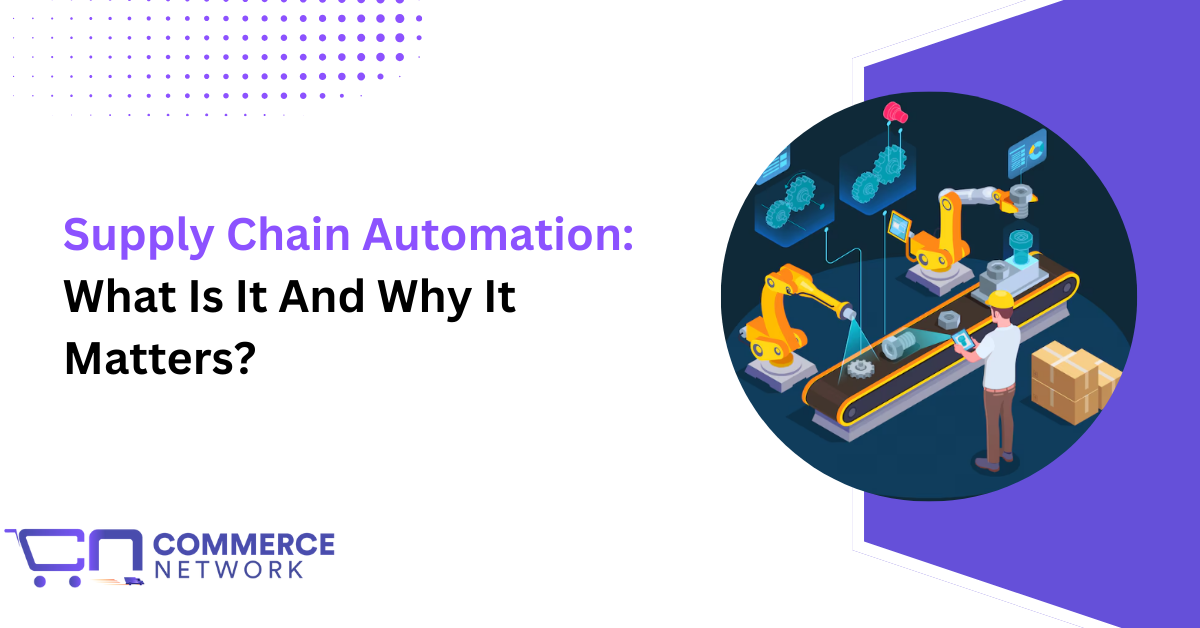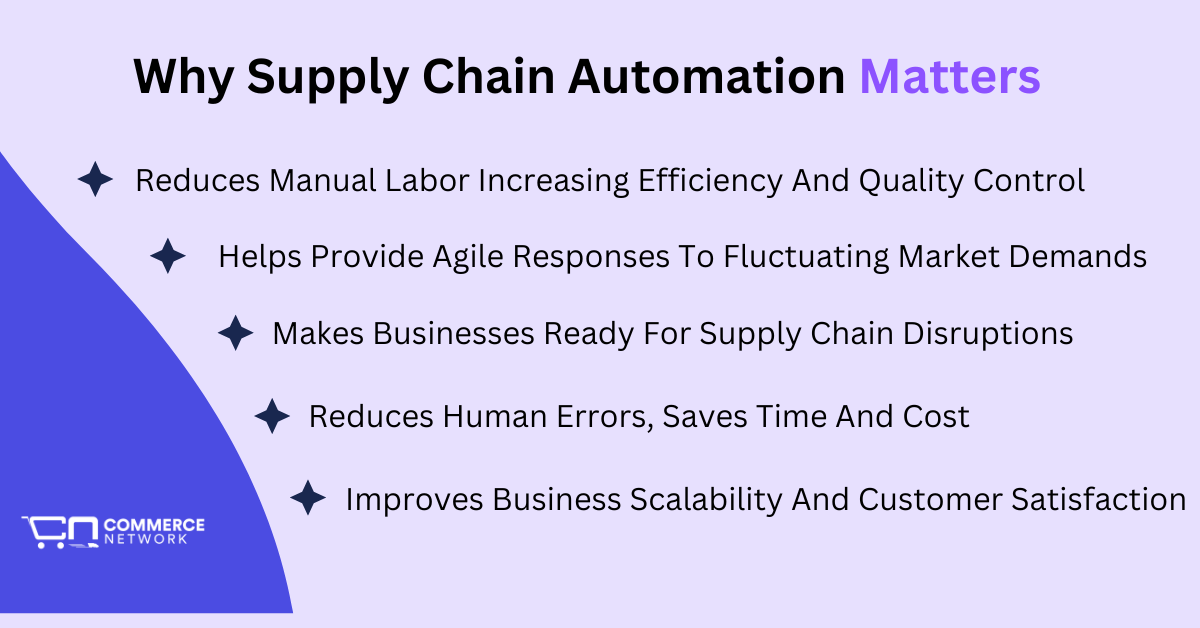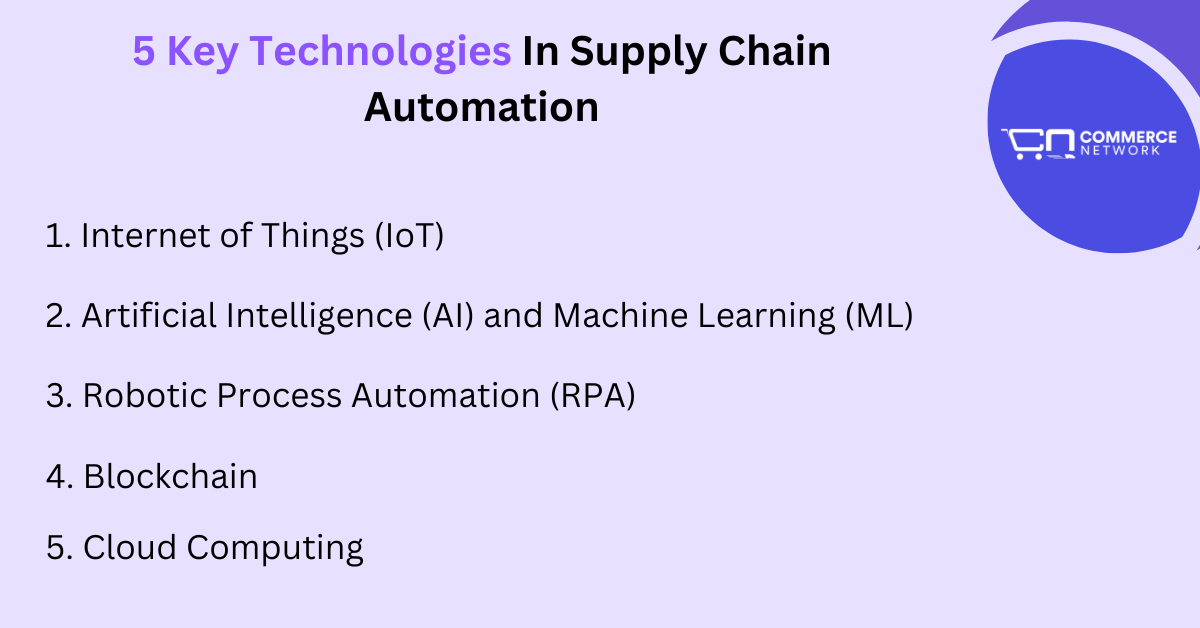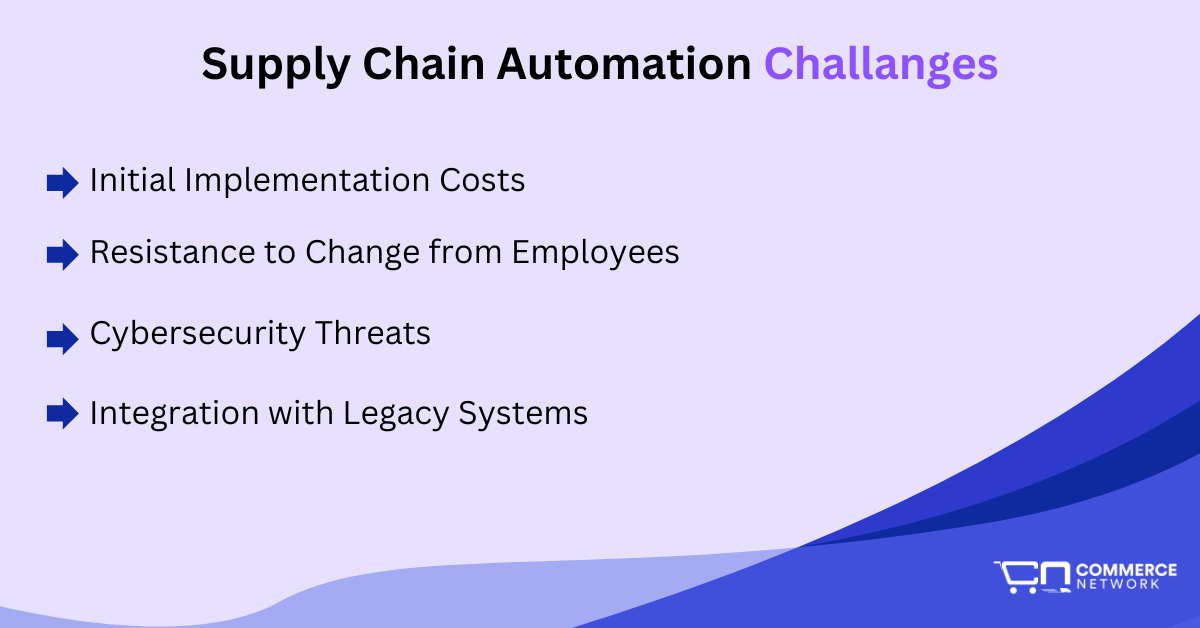By Bipin Dhungana | December 09, 2024

Businesses rely on their supply chain to deliver their products to customers. Growth, now more than ever, depends on efficiency, reliability, scalability, credibility, and fast response to changing customer demands.
In such a dynamic and ever-growing market, using traditional systems for supply chain management simply is not enough. This is where Supply Chain Automation comes up.
But what exactly is supply chain automation? Why is it important? How does automation impact supply chain management? What are some crucial components of supply chain automation? How is the supply chain of a business automated?
This article dives deep into supply chain automation and provides you with the answers to all these questions and more.
Supply Chain Automation means using new technologies to automate processes in supply chain management, minimalizing human input. Automation helps businesses efficiently manage their supply chain processes by streamlining the repetitive tasks that humans may need to perform.
In today’s dynamic market environment, businesses in a supply chain network need to process and deliver goods faster and with proper quality while adequately responding to shifting consumer demands.
Legacy supply chain processes with no automation use on-site solutions with human input in manufacturing, stock inventory, data entry and processing, order fulfillment, and delivery tracking.
These processes are labor-intensive, expensive, and time-consuming. This becomes a problem in the current environment as customers have frequent orders, require faster processing and delivery of goods, and demand real-time visibility and tracking of the products.
Using legacy systems of supply chain simply cannot keep up with this trend in the current scenario, not to mention in the future where demands will grow and change more and more.
Moreover, there are often disruptions in the supply chain due to a variety of reasons like geopolitical, technological, environmental, legal, or administrative. Responding to these changes requires accurate data and forecasting methods that traditional systems simply cannot handle.
This makes automating the supply chain a crucial procedure that needs to be followed by all businesses inside a supply chain network.
Supply chain automation is critical mainly because.

A retailer owns a large clothing store.
His supply chain network consists of the following:
He gets his items from a supplier and sells them to customers through direct contact, online storefronts, as well as e-commerce marketplaces like Amazon, Walmart, and Shopify.
Scenario: A customer requests the purchase of 25 items of shirts.
Let us take a look at how this scenario plays out when the retailer uses manual vs automation for his supply chain.
Using automation clearly helped the retail business improve their efficiency, keep the customer and supplier satisfied improve reputation, make the business easily scalable, and increase the potential for future profits.
Supply chain automation has many benefits. However, 7 of the most key ones include:
Automation reduces manual tasks, provides accurate reports and data for strategic planning, digitizes payment systems, enables faster delivery schedules, and saves overhead costs and employee time by reducing administrative materials like papers and pens,
It also eliminates data entry into spreadsheets, reducing constant manual oversight of products and inventory tracking, thus saving time for staff.
Employees who were previously needed for supply chain tasks can now use their time for more strategic tasks like planning, thus increasing the efficiency of business processes.
Cost saving and improving efficiency also include minimizing overstock of inventory, optimizing financial transactions, reducing wastage of raw materials, and proper order tracking.
All this cost saving and improved efficiency ultimately results in boosting profits and growing the business.
Manual data-entry errors, even small ones often cost businesses millions or tens of millions of dollars of losses. Moreover, there could also be an oversight by humans as people cannot constantly remain vigilant during each supply chain process.
Delays are also inevitable when using traditional systems requiring manual inputs. Furthermore, when errors and delays occur together, business owners simply cannot grasp quickly enough where the error occurred during the supply chain and how the delay came to be.
Supply chain automation reduces manual errors by eliminating the need for humans to be present during each supply chain process.
Moreover, business owners can grasp accurately where an error occurred and where a delay is caused through automation, as automation provides real-time data and analytics on the entire supply chain.
This enhanced supply chain visibility makes it so that error-prone areas can be easily identified, effective error-handling techniques can be quickly implemented, and delays for product deliveries can be reduced.
Automation ensures fast delivery of products with optimum quality, making customers happy. Customers can get real-time updates on their product status with the integration of automation technologies in the supply chain.
Supply chain automation also enables faster responsiveness of customer concerns as staff are quickly notified through automatic alerts.
Simplifying the return process of goods, improving automated financial transactions, and optimizing inventory management to reduce stockouts of goods thereby reducing customer frustrations, and improving customer satisfaction.
Automation also streamlines communication procedures, lowers prices of goods through efficiency, and mitigates disruptions, thus improving customer relationships.
Automation enhances decision-making with real-time and historical data analysis. So, businesses have enough time to adapt to any significant market changes. It also provides flexibility to pivot a business process into favorable outcomes in shifting market dynamics/
The use of real-time data gained from automation can be used to drive insights perform predictive analysis and make efficient response strategies when facing fluctuating customer demands.
In addition to this, automation technologies are configured to be scalable in the future so that large-volume transactions in order procession, production, manufacturing, and delivery can be carried out without a hitch.
Automating the supply chain process also saves costs which can be used to scale the business.
Automated tools for the supply chain help mitigate the risk associated with compliance issues. These tools use predictive analytics to predict the risk of compliance by analyzing historical and current data.
Predictive risk assessment helps with the identification of potential compliance issues so that these issues can be addressed before any supply chain operations can be affected.
If any incident involves a breach of compliance, automation can help by quickly and accurately finding out the cause, enabling fast responses so businesses can effectively take action to reduce the risk.
Preparation of documentation for compliance is a big problem in a large supply chain network. Automation can handle all the preparation by quick analysis of the large volume of data and prepare accurate analytics needed for compliance reporting.
Furthermore, automation can also help identify any overlooked areas needed for compliance documents and make sure the documents are submitted on time.
When partners on a supply chain network all adapt automation, it becomes exceedingly easy to communicate and collaborate.
For example, a supplier with automation can easily send an automatic request to a manufacturer for a certain product component. The supplier can then send the product directly from the manufacturer’s facility into his customer’s hand with fast delivery and real-time visibility.
Moreover, indirect partners (e.g. suppliers of suppliers) can also benefit from an efficient supply chain boosted by automation.
Automation also allows for increased collaboration opportunities by enabling efficient communication, eliminating manufacturing and logistical hurdles, and making sure that all partners and kept up-to-date on the order fulfillment process.
With an automated supply chain that boosts productivity and increases efficiency, it is only natural to scale up growth.
Businesses that rely on legacy systems can never hope to match up to automation-enabled modern supply chains.
Automating the supply chain means an effective way to generate more with less. It also means cost saving, boosting production, improving customer relationships, ensuring fast delivery, increasing credibility, and making a brand name for the business.
All in all, these measures help increase competitive edge when every small lead increases the chances of taking more market share from competitors and increasing sales potential.

The Internet of Things (IoT) is used in supply chain automation for the following tasks.
Real-time monitoring: Tracking the flow of goods in the supply chain process through sensors embedded in IoT devices. It also involves monitoring the environmental conditions when producing, transporting, and storing goods while providing constant updates.
Predictive Maintenance: IoT can help predict the failures of equipment by analyzing their present condition, incorporating their service data, and performing analysis on their health. This allows proper maintenance of critical supply chain machinery before any significant losses come about.
Demand Forecasting: AI-powered algorithms leverage historical data and market trends to provide precise demand predictions. This enables businesses to optimize inventory management, minimizing the risks of stockouts or overstocking.
Process Optimization: AI analyzes data patterns to uncover inefficiencies within supply chain processes, providing valuable insights that help businesses streamline operations and enhance overall efficiency.
Automated Decision-Making: Machine learning models can automate key decisions in logistics, such as optimizing delivery routes in real-time based on current traffic conditions.
Task Automation: RPA streamlines repetitive tasks like data entry, order processing, and invoice generation, minimizing human error and allowing staff to concentrate on more strategic functions.
System Integration: RPA enables the integration of diverse software systems across the supply chain, ensuring smooth data flow between departments and enhancing overall coordination.
Enhanced Transparency: Blockchain technology offers a decentralized ledger that records every transaction within the supply chain, allowing all stakeholders to verify the authenticity and status of products at any stage.
Smart Contracts: Blockchain supports smart contracts that automatically execute transactions when specific conditions are met, streamlining payment processes and eliminating delays commonly associated with traditional contract management.
Scalability: Cloud computing offers flexible resources that enable businesses to scale their IT infrastructure in response to demand changes without requiring large upfront investments.
Collaboration Tools: Cloud-based platforms enable seamless collaboration among supply chain partners by providing shared access to data and applications, improving communication and coordination across the entire network.
Data Storage and Analysis: Cloud computing provides powerful storage solutions for vast amounts of supply chain data, supporting advanced analytics that drive informed decision-making and operational enhancements.
Inventory Management and Optimization
Automation revolutionizes inventory management by providing real-time tracking and advanced predictive analytics.
Businesses can maintain optimal stock levels, avoid overstocking, and minimize the risk of stockouts, which ensures operational efficiency and cost savings. Automated systems analyze past sales data, seasonal trends, and market fluctuations to forecast demand accurately.
This proactive approach enables businesses to allocate resources effectively, reduce holding costs, and streamline the replenishment process.
Additionally, real-time updates allow managers to monitor inventory levels across multiple locations, making it easier to adjust strategies as needed.
Order Processing and Fulfillment
Manual order processing often leads to delays and errors that can impact customer satisfaction.
Automated systems eliminate these issues by streamlining order entry, validation, and processing. Orders are received, verified, and queued for fulfillment without manual intervention, significantly reducing lead times.
Automation also integrates invoicing, payment processing, and order tracking into a cohesive system, providing customers with transparency and businesses with control.
This seamless approach enhances customer satisfaction by ensuring accurate, timely deliveries and efficient communication throughout the fulfillment process.
Warehouse Automation and Robotics
Warehousing is a critical component of the supply chain, and automation plays a key role in optimizing its operations.
Technologies such as Automated Guided Vehicles (AGVs), robotic arms, and Warehouse Management Systems (WMS) enhance picking, packing, and sorting accuracy while reducing dependence on manual labor.
Robots can work around the clock without fatigue, increasing productivity and decreasing operational costs.
Automated systems also utilize space more efficiently by organizing inventory based on demand frequency and product compatibility.
These innovations improve warehouse throughput and ensure quicker delivery times, even during peak demand periods.
Transportation and Logistics Automation
The transportation and logistics sector has seen significant advancements in automation, particularly in fleet management, route optimization, and real-time tracking.
Automated fleet management systems monitor vehicle performance, fuel consumption, and maintenance schedules, ensuring efficient operation and reduced downtime.
Route optimization software uses real-time data, including traffic conditions and weather forecasts, to identify the most efficient delivery routes.
This reduces delivery times and fuel costs while improving customer satisfaction. Real-time tracking enhances supply chain visibility, allowing stakeholders to monitor shipments and address disruptions proactively, further improving reliability and trust.
Vendor and Supplier Relationship Management
Managing relationships with vendors and suppliers is crucial for a well-functioning supply chain, and automation simplifies this process.
Automated tools streamline procurement by generating purchase orders, tracking shipments, and ensuring timely payments.
These systems facilitate seamless communication between businesses and their suppliers, improving collaboration and transparency.
Predictive analytics can assess supplier performance and identify potential risks, enabling businesses to address issues before they escalate.
Automation fosters stronger partnerships by ensuring consistency, efficiency, and mutual trust, which are essential for a resilient supply chain.
Electronic Data Interchange (EDI) serves as a backbone for supply chain automation by enabling seamless data exchange between trading partners.
It automates the transmission of essential documents like purchase orders, invoices, shipping notices, and inventory updates, eliminating the need for manual data entry. By standardizing communication formats, EDI ensures that information is accurately shared across different systems, even when partners use disparate technologies.
This streamlining reduces processing times, minimizes errors, and enhances overall efficiency.
EDI also integrates with other automation tools such as Warehouse Management Systems (WMS), Enterprise Resource Planning (ERP), and Accounting Systems, creating a cohesive, automated workflow that keeps supply chain processes running smoothly.
Learn More: How EDI enhances Supply Chain Automation For B2B, B2G and B2C Transactions
Examples of EDI Integration in Real-world Supply Chains
In the retail sector, large companies like Walmart rely heavily on EDI to coordinate with thousands of suppliers.
EDI enables automatic order placements, real-time inventory updates, and fast invoicing, allowing Walmart to maintain its highly efficient supply chain. Similarly, in manufacturing, automotive giants use EDI to manage just-in-time (JIT) inventory systems.
Suppliers receive automated notifications about production needs, ensuring components arrive exactly when needed, reducing storage costs and waste.

Initial Implementation Costs
Automation demands substantial upfront investment in technology, infrastructure, and employee training.
For smaller businesses or those with limited budgets, these costs can be prohibitive. Setting up automated systems often requires purchasing advanced hardware and software, upgrading existing facilities, and potentially redesigning operational workflows.
Beyond the initial expense, there are ongoing costs for system maintenance, updates, and scaling as business needs evolve.
While the long-term benefits of automation are significant, the high initial costs can create financial strain, especially for organizations that need immediate returns on their investment.
Resistance to Change from Employees
Employees may resist the adoption of automated systems due to concerns about job displacement or challenges in adapting to new technologies.
This fear often stems from a lack of understanding about how automation can enhance their roles rather than replace them. Additionally, discomfort with unfamiliar systems can slow adoption and reduce the efficiency of implementation.
Addressing this challenge requires a strong change management strategy, including transparent communication, training programs, and opportunities for employees to upskill.
By fostering a culture that values technological advancement, businesses can ease the transition and reduce resistance.
Cybersecurity Threats
Automation increases the interconnectedness of supply chain systems, creating a larger digital footprint and exposing organizations to cybersecurity threats.
These threats include data breaches, ransomware attacks, and system hacking, all of which can disrupt operations and compromise sensitive information.
As supply chains rely heavily on real-time data exchange, even minor cyber incidents can have cascading effects, leading to financial losses and reputational damage.
To mitigate these risks, businesses must invest in robust cybersecurity measures such as firewalls, encryption, and regular system audits, as well as employee training to prevent phishing and other attacks.
Integration with Legacy Systems
One of the most significant technical challenges in adopting supply chain automation is integrating new technologies with outdated legacy systems.
Many organizations still rely on older systems that lack the compatibility needed to work seamlessly with modern automation tools. Bridging this gap often requires costly customizations or a complete overhaul of existing systems, which can be time-consuming and disruptive to operations.
Additionally, compatibility issues may arise during the transition period, leading to data inconsistencies and operational delays. Successful integration requires careful planning, phased implementation, and collaboration with experienced technology partners to ensure a smooth transition.
Predictive Analytics for Demand Forecasting
Advanced analytics and AI-driven models will refine demand forecasting by analyzing historical data, market trends, and real-time variables, enabling businesses to anticipate customer needs and optimize supply chain operations.
Autonomous Vehicles and Drones in Logistics
Self-driving trucks and delivery drones will revolutionize logistics by reducing transportation costs, improving delivery times, and minimizing human errors in the last-mile delivery process.
The Role of Digital Twins in Supply Chain Optimization
Digital twins are the virtual replicas of physical supply chain systems. They can be used to provide real-time insights, enabling scenario modeling, process optimization, and proactive issue resolution to enhance overall efficiency and agility.
In summary, supply chain automation revolutionizes modern logistics by boosting efficiency and adaptability. Leveraging technologies like AI and IoT, companies can optimize operations, cut costs, and elevate customer satisfaction. In navigating the challenges of global markets, embracing automation is crucial for building resilience, fostering sustainable growth, and staying ahead in a competitive landscape.
Improve Your B2B, B2G, and B2C Ecommerce?
Integrate EDI For Efficiency, Compliance, and Scalability?
Just Curious About EDI?
Give Us A Call
202-280-7060